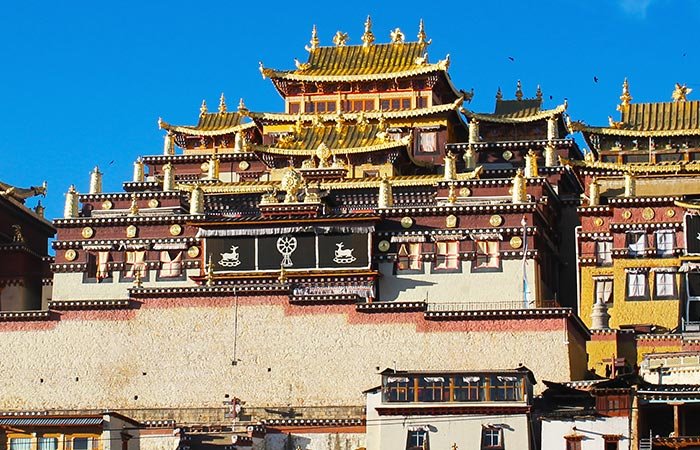Where am I : India Tour Packages » Most Popular Packages » Sera Monastery Tour Packages
View Details

Destinations Covered : Lhasa » Namtso Lake » Sera Monastery
Sera Monastery Journey
As an essential Buddhist monastic institution serving as a religious education center, Sera Monastery is not only considered one of the six main Gelugpa monasteries in Tibet but also revered as one of the six principal monasteries of Tibet Buddhism. In 1419, Jamchen Chojey Sakya Yeshe (1355–1435), a disciple of Je Tsongkhapa, built it. With the sound of lamas chanting Buddhist scriptures at Tsochin Hall and seeing Buddhists debating in the large debating courtyard, a visceral sense of holiness permeates the entire being. Thousands of murals adorn the building walls, creating a sense of being in the heaven of Buddhism as if one were accepting the monastic rites and Buddhist doctrines. The library and printing press of Sera Monastery Journey provide a comprehensive overview of the past and present of the Monastery. In the Sera Kora, you can get a more comprehensive understanding of the architecture of the Sera building complex and how this Monastery can function as a self-sufficient city. Following the professional guide below, explore Sera Monastery to the fullest.
A little history
A great teacher of the Mahayana Buddhist tradition, Lama Tsongkhapa led the establishment in 1419 under Jamchen Choeje. There are three types of colleges: Sera Mey, Sera Ngagpa (Tantric), and Sera Jey. There were monks' deaths and damage to the colleges at Sera during the Tibetan uprising of 1959 and the Dalai Lama's escape from Tibet into India. The Sera Mayahana Monastic University in Exile was founded near Mysore in South India near the present site in 1970 after hundreds of Sera monks fled to India. The Sera Monastery in Lhasa has survived the Cultural Revolution despite damage and diminishment and is being gradually restored. However, it still operates as a monastery, has impressive architecture, and houses a stunning collection of sacred art despite being a mere shadow of its former self. Ming Jowo is a sculpture dating from the 15th century, a statue of the Buddha Sakyamuni. The environment is beautiful, with cobblestone streets, temples, and schools. The highlight of visiting the Monastery will be watching the monks discuss and debate inside the shaded courtyard behind the main temple. Every day, hundreds of red-robed monks gather in small groups and practice their debating and debate skills. Sera Monastery is one of the three great Gelukpa university monasteries in Tibet. The original Sera Monastery was in Lhasa, north of the Jokhang Temple. Although badly damaged, it is still standing and has been heavily repaired. Today it houses a few hundred Buddhist monks.
Visiting Sera Monastery
There are two sections in the complex: Eastern and Western. When walking around Tibetan monasteries, you should always walk clockwise. Sera Me, Ngagpa, and Sera Je are the three colleges on the west. Among the most critical sites for families with children are the Sera Je college building and its Hayagriva chapel (horse-headed deity). It is common to see kids coming out of the Sera Je with an ash mark on their noses when Tibetans bring their kids for blessings. The Assembly hall is located on the west side of the campus. The building in the center of the complex is the largest and most impressive of the entire complex. There is a tree-lined debating courtyard to the northwest of the complex. This courtyard is where the famous monks debate every day except on Sundays. Discussions usually begin around 3 pm on weekday afternoons. Around 3 in the afternoon, many chapels will close. That's why early afternoon, around 2 pm, is the best time to visit Sera. There will be time for you to walk through the monastery complex, visit the Assembly hall and watch the debates in the courtyard.
Monk’s debate
Monks' debates in Sera monastery courtyard: Buddhism requires debates as part of its study. Gelug monks believe they should practice what they've learned and study the texts. They aim to ensure they are comfortable with religious topics by asking each other questions. It is an intriguing performance for visitors. During their talks, monks use gestures to accompany their discussion. As a result, they swap partners, engage in friendly banter, and have fun. The monk will be standing, asking questions. There's usually another monk or several sitting before him waiting to answer. If the monk claps his hands after asking a question, it is time for a response. A must-read! Your phone can take pictures, but not video or professional cameras.
The great assembly hall
There is an excellent Assembly hall at the Sera monastery called the Tsokchen. Construction of the four-story structure began in 1710. One hundred twenty-five columns, with a skylight at the center, support the structure. The murals of the Four Guardian Kings will greet you when you enter the Assembly Hall. Five chapels are located inside. Giant thangkas are hanging from the ceiling (images of Buddha). Sera's founder, Jamchen Choje, is the statue in the center. The sides of the temple have statues of Maitreya (5 meters tall) flanked by lions, as well as the Fifth, Seventh, Twelfth Dalai Lamas, and Tsongkhapa with his disciples. The first floor has three chapels. One of the essential features of this chapel is the six-meter-tall statue of Maitreya or Future Buddha (called Jampa in Tibetan). On the chapel's south wall is displayed the precious text of the Kangyur (teachings of Buddha) printed in 1410 (out of the 108 original scriptures, three have been lost). Red lacquer covers each text with gold decorations carved into it. A thousand-arm Chenresig statue (Avalokiteshvara Buddha) was found in Pabongka and is displayed in another chapel on the second floor. They incline their heads toward the statue, believed to bring blessings from the heart.
Festival celebration in Sera Monastery
The Sera monastery is always busy with hundreds of locals and pilgrims who visit it daily from all over Tibet. Also, Sera is the site of a massive celebration of Shoton, or yogurt festival, which attracts large numbers of Tibetans once a year. In the Tibetan calendar, June and May were traditionally times of meditation. As a way to gain merit and prevent many killing insects, monks stayed inside during that time. It is typical for monks to retreat to caves or spend time in meditation in monasteries away from the midsummer heat. Tibetans offer freshly made yogurt to monks at the end of each month. All visitors are blessed in return by monks holding up giant thangkas, which are images of Buddha. In ancient times, monasteries built particular walls to hold these enormous thangkas once a year. The Shoton Festival is celebrated in Tibet on August 29, the 6th lunar month of the Tibetan calendar (usually in August of the western calendar). In the morning, the thangka is displayed by the monks at the Drepung monastery. The crowd receives blessings from a thangka in Drepung early in the morning, followed by blessings from a second thangka in Sera in the afternoon. As many temples in Sera are shut during the Shoton Festival, the monks are involved in festival activities, but you can still visit the Monastery at this time. Numerous pilgrims will be wearing their best jewelry and traditional clothing.
Sera Hermitage
Several nunneries and temples can be viewed on the mountainside above and around Sera Monastery, which is part of Sera Monastery Heritage. If you have more time in Lhasa, many of them are worth exploring.
• Sera Utse
The yellow temple behind Sera monastery is visible from the Monastery when you're visiting Sera. The Sera Use meditation cave is situated in the center of the complex.
During the Cultural Revolution, the Monastery was destroyed and is currently being rebuilt. It is only a short hike, but it is challenging. As the new road nears completion, Sera Utse will be more accessible in the future.
Pabongka
Pamongka is the most important and oldest site in Sera Hermitage. One of its caves was used as a place of meditation by Tibetan King Songtsen Gompo in the 7th century. The cave is still accessible today.
Pabingka was also home to Tsongkhapa while he was a hermit. Pabongka is most famous for its self-arising image of Rigsum Gompo Trinity and its carved Tibetan alphabet "Om Mani Padme Hum.”
What to see and do?
Sera Me, Sera Ngapa, and Sera Je are three colleges you can visit.
Sera Je has a debating courtyard where monks debate. Monasteries in Tibet are open every afternoon from 3-5p except on Sundays, but this is subject to change. Walk west from the entrance of the monastery grounds to the Sera Kora, the prayer circuit circling the grounds.
Shoton festival
Shoton Festival (about the last ten days of August in the solar calendar) is celebrated on June 30 of the Tibetan calendar. It is one of the most important and attractive traditional festivals in Tibet.
The grand ceremony of sunning the Buddha
There will be ethnic songs and dances performed at Norbulingka Palace and famous Tibetan operas held at Sera and Drepung monasteries to see the Buddha Thangka. In Sera Monastery, during that time, attendees will be able to witness the special ceremony of sunning the Buddha, which is the highlight of the festival. Be sure to attend.
Sera bengqin festival
Sera Monastery annually celebrates a festival known as the Sera Bengqin Festival, also known as the Blessing of the Dagger of Exorcism, on December 27. Both monks and devotees attend the festival. There will be tens of thousands of Tibetan Buddhists trekking to the Monastery for its annual ritual on that day from the Tibet Autonomous Region and the neighboring Tibetan-dominated regions.
Traditionally, pilgrims to the Monastery hold a pure white Khada in hand and move slowly in a long line before entering the Monastery to pray. At the same time, the Dalai Lama blesses the Vajra Pestle, a treasure housed within the Monastery.
Following that, the Khenpo (president) briefly places the Pestle on the heads of the monks and disciples. According to traditions, celebrating the festival and being touched by a Vajra Pestle can ward off hardship and disaster and bring happiness and prosperity in the New Year. Traditionally, a 24-hour festival is held before the Tibetan New Year as a big celebration.
Admire the treasured historical relics
Since the Yongle Emperor of the Ming dynasty gave Sakya Yeshe many precious objects when he returned to Tibet from Beijing in 1416, these historical relics of about 500 years can be seen in Sera Monastery, from Buddhist texts, Buddha statues, mafors to gold and silver items, etc. You can not only see the 500+-year-old Sakya Yeshe statue still in bright color, but also appreciate more than ten thousand gold and bronze Buddha statues made in Tibet, bronze Buddha statues, classical texts, frescoes, Indian Buddhist thangkas and musical instruments, and many-colored stone paintings expressing the worship of the people, and so on.
Join local activities
Among all the festivals of Sera Monastery, Sera Bengqin Festival is a grant and unique, which means the blessing festival of “vajry mortar,” which is an exorcism dagger. It is said that in the fifteenth century, an exorcism dagger was transmitted from India, and every morning of December 27 of the Tibetan calendar, more or less at the end of January in the Gregorian calendar, it was sent to the Potala Palace and presented to the Dalai Lama to bless this dagger. It would then be sent back to Sera Monastery, and the Khenpo at Sera Ngapa Collage would bless all monks and visitors holding this dagger to signify that they were all blessed by the Buddha Bodhisattva and patron deity. Since then, every year on that day, more than 10 thousand believers come to the Sera Monastery and wait for the blessing.
Things to do nearby
Walk the Kora around the Monastery
You can join Tibetans as they circumambulate the Monastery with kora (the circumambulation always takes place clockwise), and you will be able to savor the local culture and observe exciting sights. It will take about 30 minutes to walk around the Monastery.
Visit the local tea house.
Many locals gather at the tea house inside the Monastery to enjoy a cup of sweet tea or lunch. Monks run the tea house, and many locals come here to take tea or lunch.
Rest in the shade of trees and prepare to tour the complex of monasteries with Tibetans.
See the printing press.
Traditionally, wooden blocks with texts imprinted on them are pressed onto the pages.
Walk around the Monastery to see rock paintings.
On the hills surrounding Sera, you can see many rock paintings. Most of them depict Buddhas and deities.
Travel tips
To catch the monks' debating, take a stroll around the monastery grounds after lunch, and then see the debating in the late afternoon. There is nothing like the debates you might see in the West in Buddhist dialectics. These are ancient, highly ritualized forms of discussion. During the question-and-answer period, the monk who asks the question stands while the monk answering the question sits. Standing monks may slap their hands together when questioning actions with spiritual meaning, such as awakening wisdom, which isn't meant to be aggressive. It is a series of philosophical questions associated with the Buddha Dharma being asked and answered. A general entrance fee and a fee per chapel will be charged if you wish to take interior photos. Video is charged separately at a much higher cost.
Special tips for traveling to Sera Monastery:
- Every year, on December 24, the temple will hold the King Kong Blessing Festival. There will be blessings from King Kong for the believers. Many believers will come here to participate in the ceremony at that time. Visitors can also come to pray for evil.
- According to the rituals of Tibetan Buddhism, walking around the temple and turning around the Monastery should follow the clockwise direction.
- Respect the beliefs of local people; do not point your fingers at Buddha statues. After entering the room, you must take off your hat and keep quiet. You can't take photos casually.
- After 3:00 pm, there will be many rooms closed. It is recommended to visit this place in the morning or at noon. In the afternoon, you can take a look at the debate.
- Keep as quiet as possible while watching and filming. Don't take pictures always; try to reduce the impact on the deaf?
- The altitude of Sera Monastery is relatively high. Visitors new to Lhasa should be careful not to engage in strenuous exercise to avoid altitude sickness.
Best time for visiting Sera Monastery
You can visit Sera Monastery at any time of the year. Still, if you have the chance, it is highly recommended you visit during two major Tibetan celebrations: Shoton Festival and Sera Bengqin Festival. It is a pleasure to travel to Tibet because of the grand religious ceremonies and the colorful civil activities.
Bottom line
A highlight of a Sera Monastery Journey is watching the monks debate their scriptures. A group of monks in traditional red robes gathers every afternoon in the monastery courtyard. Many people make unusual gestures during a debate, such as bouncing up and down. Watching them is fascinating. Sundays are not the days for monk debates. Your travel advisors and Tibet guides are always open to changing your itinerary while with us so that you don't miss this highlight. Those who wish to hike to Sera Monastery can start their journey from Phabongka Monastery, which lies near Lhasa. It takes approximately 6 hours to complete the hike, which is approximately 13 km long (8 miles).
Speak to our Experts!
Instant Quote, Best Deals - 100% Customizable, Includes hotels + car + guides Cost depends on various factors like, number of people you are, travel dates, category of hotel and transportation etc.Drop your Inquiry to get the best deals as per your requirements. 100% Satisfaction Guaranteed. Rated 5* in TripAdvisor.Loading...




